The European Union Summary Report on Trends and Sources of Zoonoses, Zoonotic Agents and Food-borne Outbreaks in 2010
Published by the European Food Safety Authority, this joint scientific report brings together data on the occurrence of zoonoses, zoonotic agents and food-borne outbreaks and zoonoses cases reported in humans.
Zoonoses are infections and diseases that are transmissible between animals and humans. In order to prevent zoonoses from occurring, it is important to identify which animals and foodstuffs are the main sources of infection. For this purpose information aimed at protecting human health is collected from all EU Member States and analysed by ECDC and EFSA.
Executive Summary
The report, providing data on 15 zoonotic diseases in the European Union for 2010, supports the European Commission and EU Member States in their consideration of possible measures to protect citizens from risks related to zoonoses.
The report highlights a positive progress in the reduction of reported human cases of salmonellosis by almost 9% in 2010, as well as decreases in other zoonoses such as infections caused by Yersinia enterocolitica, Trichinella and Listeria monocytogenes. “Decreases in human cases of salmonellosis and other zoonotic diseases show that EU level control measures, resulting from surveillance of disease in humans with information from food and animals, are effective”, states Johan Giesecke, Chief Scientist at ECDC.
On the other hand, the number of cases of campylobacteriosis has been increasing over the last five years, and human cases of Shiga toxin/verotoxin -producing Escherichia coli (STEC/VTEC) are also increasing. These trends “highlight the need of further joint efforts”, continues Prof. Gieseke. “For this, ECDC will continue to strengthen its links with all important partners and foster collaboration in order to decrease the occurrence of these diseases in the EU”.







